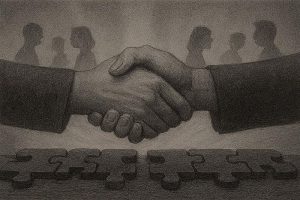He was fifty-two, a veteran business head with decades of achievements behind him. Yet when his role was eliminated, his job hunt dragged into months of rejections and silence. His résumé, which once commanded respect, now elicited polite interest – and then nothing. The feedback was nearly identical: “We are examining other candidates, and we will get back to you.” And then just silence.

This wasn’t about performance. It was a bias many in India are now confronting – Ageism in the Workplace.
Why Ageism Is Gaining Ground in India
India boasts one of the youngest populations in the world – median age around 28 – and organisations often mirror that youth bias. Several forces are amplifying age discrimination today.

Technological disruption plays a major role. With AI, automation, and digital platforms changing how business is done, organisations often equate “modern skills” with youth. A manager in her late 40s told me she was passed over for a role because she “didn’t tweet enough” or “wasn’t present on the creator economy.” The narrative is clearly becoming – if you didn’t grow up in the age of Gen Z, you might not “get us.” So seasoned leaders are judged not only by what they know, but when they learned it.
There’s also the salary equation. By the late 40s and 50s, compensation is usually at its peak. At the same time, companies can bring in younger professionals at a fraction of that cost. A Randstad survey found that 31% of Indian employees reported experiencing or witnessing age-related bias at work. For those over 55, 29% said they had personally encountered it. Cost pressures only make these perceptions sharper.
Another factor is adaptability. Years of seniority often mean less involvement in execution. When leaders stop engaging with tools, data, or new ways of working, they can be perceived – fairly or unfairly – as “stuck.” A CFO who has not built a financial model in years or a CHRO who cannot create her own data dashboard sends a subtle but damaging signal: “I am above the work.” In leaner, faster organisations, that doesn’t fly at all.
Then comes the network trap. Many senior leaders mistake visibility for security. They are invited to panels, their phones ring with vendor calls, they are profiled in trade magazines. But much of that visibility is position dependent. Once the title is gone, the calls dry up. True networks – the kind built on respect, reciprocity, and relevance – are often neglected.
And finally, there is cultural bias. In India, youth is often equated with dynamism, risk-taking, and being “in touch” with trends. Older professionals are sometimes quietly labelled as cautious or slow. In multinational firms in India, 41% of employees said they had witnessed age-related stereotypes, compared to a lower share in local firms. Age, in short, is becoming a proxy for assumptions about energy and adaptability.

What Organisations Can Do
For companies, choosing youth over experience may look efficient in the short run. But in doing so, they risk losing precisely what is most valuable in uncertain times: judgment, perspective, and the ability to mentor future leaders.
Organisations can decouple cost from value. Senior professionals need not always sit in expensive, full-time leadership chairs. Many can be engaged as advisors, part-time executives, or project-based mentors – arrangements that preserve expertise without creating financial strain.
They can also create cross-generational teams. Pairing younger, digitally fluent managers with seasoned leaders allows both groups to grow. Younger employees gain guidance and resilience; senior leaders absorb new tools and approaches.
Another move is to invest in continuous reskilling across all ages, not just for the young. Too often, training budgets are tilted toward early-career employees, leaving senior leaders behind. Embedding lifelong learning as a cultural norm ensures that older employees are not left to fend for themselves.
Finally, organisations must confront their own bias. Just as gender and inclusion became board-level priorities a decade ago, companies can monitor age diversity. By tracking the representation of candidates over 45 in hiring, promotions, and leadership pipelines, bias can be surfaced and addressed.
What Senior Leaders Can Do

Individuals in their late 40s and 50s are not powerless in this story. There are many ways to stay visible, employable, and valued.
Leaders can renew their “doing” muscle by rolling up their sleeves and learning the latest tools in their field. A CFO who learns to work directly with new financial analytics software, or a sales director who experiments with digital CRM dashboards, signals relevance more strongly than any line on a résumé.
They can build reputations that travel beyond titles by writing, mentoring, teaching, or contributing to industry forums. When credibility comes from true thought leadership and impact, not just from a corporate badge or from using generative AI on LinkedIn, it remains intact even in career transitions.
They can strengthen authentic networks by investing in relationships that go beyond their positions. A vendor, a younger colleague, or a startup founder may one day become the bridge to a new opportunity.
They can prepare financially so they have flexibility in accepting new opportunities, even if the initial role pays less. Sometimes a strategic pay cut or a shift into a different industry can reignite a career in unexpected ways.
And most importantly, they can model curiosity and humility. Admitting what they don’t know, asking questions, and showing a willingness to learn creates a powerful signal: that they are not resting on their past, but continuously reinventing their future.
Ageism in India is real and rising. Technology, salary pressures, and cultural narratives are reshaping how experience is valued. But it is not destiny.
Organisations can design systems that make the most of seasoned talent while preparing the next generation. Senior leaders can reinvent themselves, building resilience, relevance, and networks that keep them in the game.
After all, a career should not be defined by chronology. It should be defined by contribution, credibility, and the courage to keep evolving.


